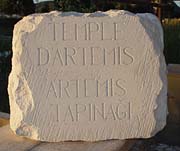

Tekmar, a major stone quarrier and fabricator based in Istanbul, Turkey, is currently assisting in the renovation of the “Letoon Temple†by providing its material, Cremo Bello limestone. This material is being supplied with meticulous and skillful workmanship without demolishing the original ruin.
Centuries ago, the early civilizations that occupied these areas were primarily fishermen and farmers. They were well known for their occupations, traditions and culture. Approximately 2,500 years ago this group began to work with stone, and they ultimately mastered the process of stone art, thus making their place in history very significant. They sculpted the stone to make magnificent ramparts, rock tombs, monuments and other sculpted works.
After the invasions of Alexander The Great, cities such as Letoon joined first with the Roman Empire and later with Byzantium, which is now modern-day Turkey. An Englishman, Charles Fellows, discovered the lost city, Lycia, in 1838, although renovations did not begin until 1950.
Excavation has been taking place since 1950, and is now being carried forward by a French team. Since 1988, the Letoon Temple has taken its place on the list of “World Heritage†sites.
The work at the site is extensive. Fluted columns are being carefully reconstructed with a blend of the original stone and new Cremo Bello limestone. Ultimately, the limestone will blend with the original stone, and the integrity of the original architecture is maintained. The decorative column bases and pedestals are also being replicated in Cremo Bello limestone, and Tekmar has also created ornate bases that sit below some of the larger stone blocks on the site. These bases were fabricated using modern technology, and they effectively replicate the original stonework that was formed by hand. Other custom work included curved three-dimensional arches, which are positioned alongside the original stonework.
Some basic blocks of limestone were also fabricated to fill in areas where blocks had deteriorated beyond the point of repair.
Moving beyond cutting and shaping, some intricate work was also done for the project, including engraved stones and intricately carved decorative pieces. “We, the Tekmar Family, are honored and proud to be a part of the renovation and restoration of such a magnificent historical World Heritage site,†stated the company. “Through the use of stone, history is preserved for generations and generations to come.â€